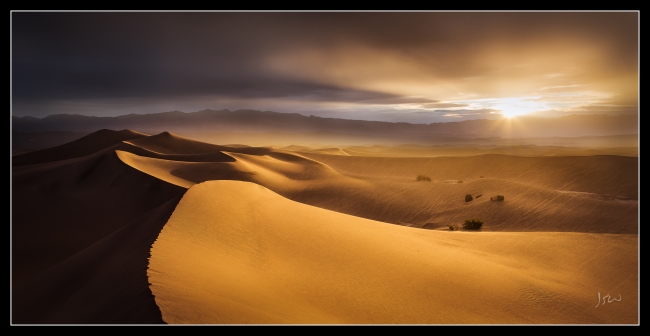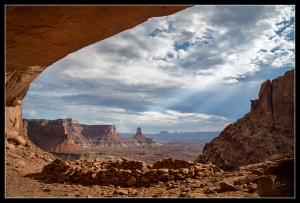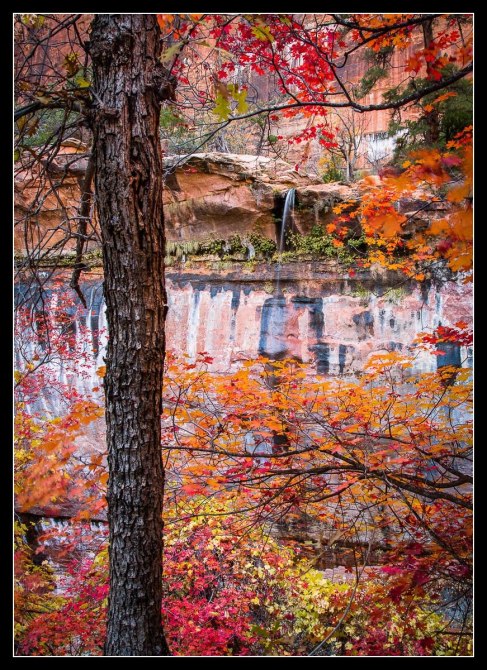“Fire and Rain”
Mesquite Sand Dunes, Death Valley National Park
This sunrise image from the Mesquite dunes is one of my favorites from my recent Death Valley trip, but it almost never happened. There’s a familiar adage among landscape photographers for getting great images: “f/8 and be there.” F/8 is the lens aperture setting (which may or may not be the right setting, of course, depending on the circumstances), but the be there part is something that I almost had to learn the hard way on this morning.
Wind and rain had been drubbing my tent for much of the night before, and when my alarm went off at 4:50 am, there was a steady rain falling and no hint of a break in the sky. I dozed on top of my sleeping bag for a while, thinking there would be no good light for sunrise and no reason to head out to the dunes as I had planned. Maybe 30 minutes later I sat straight up with the thought, “Dang, I’m stupid! I need to get out there and at least give it a shot.” Sure enough, as I quickly collected my gear and jumped in my 4Runner, I noticed a very thin sliver of clear sky on the horizon where I expected the sun to rise. I raced down the road toward the dunes, about 25 miles away, worried that my delay might have already caused me to miss a great opportunity.
When I got to the parking area near the dunes it was still raining, but my pulse quickened as I saw faint sunrays start to filter through the distant break in the clouds. I hustled out onto the dunes, noticing the lines of footprints of two other photographers. It’s still a bit of a hike from the parking lot out onto the main area of the dunes, and I knew I didn’t have much time. I had scouted this area the previous evening, and saw now that to capture the rising sun, get a good composition of the dunes, and stay out of the frame of the two other photogs, I would need to quickly hike around their back flank to the far side. The dunes were starting to take on a surreal glow as I scurried around to the spot I thought would work. The wind was picking up, the rain was still coming down, the horizon was starting to explode with a sweet filtered light, and my quads were burning as I sprinted up the last steep dune with my heavy gear, wet sand flying in my wake.
I got to the crest of the dune and stood stunned for a moment by the sublime scene of “fire and rain” before me. Then I noticed one of the other photographers on top of a dune in front of me (and lots of unattractive footprints), disturbing my planned composition. (AAARGH!) Sometimes it’s nice to include a human element for scale and impact, but this wasn’t going to work. So, I looked around quickly to assess my options, then dashed over and up to the top of the next dune, which seemed to be the tallest one around. I imagine I would have been a comical sight, particularly if replayed in slow motion, desperately sprinting the final yards to the crest of the dune while simultaneously extending and adjusting my tripod legs and attaching my camera.
I positioned the tripod and camera as quickly as I could, awkwardly struggling to stabilize it in the sloped sand, trying to keep the rain off the front element of the camera lens, and quickly adjusting camera settings and composition. I started firing off bracketed exposures, quickly at first, then slowing down as I began to just take in and savor the amazing scene. The EXIF data from my exposures tell me the good light lasted less than 5 minutes, but it was the kind of experience where time stood still for me.
I started to reorient myself to my broader surroundings, and had a sinking feeling as I realized I hadn’t been paying attention to whether there had been any lightning around. I was, after all, standing at the top of the tallest dune in the vicinity, holding on to a metal pole (tripod), in a rainstorm. I had been so focused on the sunrise and golden light in front of me I hadn’t thought to TURN AROUND to see what I’d been missing: a giant double rainbow that was so close I could practically see the wee pots o’ gold on each end! (Duh… why didn’t I think of that earlier? Sunrays coming right at me through the rain?) I spun around and clumsily tried to get a decent photo, but 24mm wasn’t even close to being wide enough, a good composition eluded me, and the rain was hitting me straight on anyway. I resigned myself to just enjoying the moment. The hasty snapshot (of one end) doesn’t do it justice, but what was really interesting was that because I was high up on the dune, the arc of the rainbow wrapped around nearly 270 degrees (all the way around above me, and partially below me). It was like I was up in the middle of a rainbow circle.
The light show ended moments later, and even though I hadn’t noticed any lightning, I decided to head for lower ground. I spent a good 20 minutes back at the car “chimping” at the images on the small display screen, and hoping my processing skills could do justice to what I had just experienced. Most of all, I was just happy to be there on this morning. And if you’re wondering: yes, my aperture for “Fire and Rain” was set to f/8. 😉





